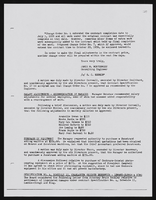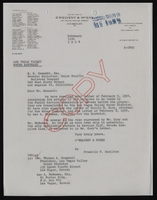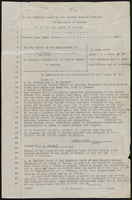Search the Special Collections and Archives Portal
Search Results
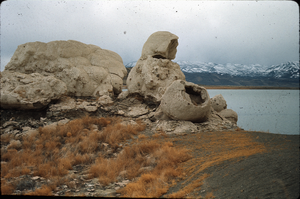
Slide of the rock formation known as The Squaw and Her Basket, Pyramid Lake, Nevada, circa 1970s
Date
Archival Collection
Description
Image
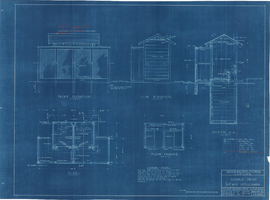
Los Angeles & Salt Lake Railroad Company double privy: architectural drawing
Date
Archival Collection
Description
From Union Pacific Railroad Collection (MS-00397). The scales are noted in the drawing. The bottom of the drawing says, "Material-Finish: All Finish Lumber Unless Otherwise Noted Shall Be [Opsas?] Wood Work Of Vault Shall Be O.P Rough. Exterior Of Privy Including Both Sides Of Door And Door Jamb: Also Wood Lattice Screen On All Sides Shall Be Painted With 3 Coats C.S. Lead & Oil Paint As Directed. Doors Shall Be Hung On 3 1/2" x 3 1/2" Botts. Doors Shall Be Provided With Rim Latch Knob Lock And Iron Barrel Bolt. Revisions: Added Vent Stacks, Seat Cover, Double Floor & Floor Shoe".
The bottom corner of the drawing states, "Union Pacific System L.A. & S.L.R.R. Double Privy 5'x8' With Lattice Screen. Ass't Chief Engineer's Office. Los Angeles, Calif. Drawn By E.C.B. Traced By E.C.B. Checked By F.W.G. Date June 14, 1926. Scale As Noted. Revised May 5. 1927. Drawing No. 15637".
Also written on the drawing: "Two to be built at East Yard, Calif. One ' ' Big Springs, Nev. ' ' Las Vegas, Nev. ' ' Borden, Utah. ' ' Elgin, Nev. 1927. ' ' Dry Lake, Nev. 1927. ' ' Wann ' ' 1928 [crossed out]."
Image
Ann Valder Papers
Identifier
Abstract
Ann Valder Papers (1963-1984) include agendas and minutes, programs, invitations, events, and newspaper clippings. The papers are limited to the time Valder spent working for the Review Journal and the Valley Times in Las Vegas, Nevada. The activities covered are her work with Southern Nevada Memorial Hospital and the American Cancer Society.
Archival Collection
Nevada Hotel and Motel Association Collection
Identifier
Abstract
The Nevada Hotel and Motel Association Collection contains items from the hospitality and service industries from 1979 to 1992. The collection consists of trade publications, conference brochures, and industry reports focusing on the service and hospitality industries in Nevada.
Archival Collection
University of Nevada, Las Vegas Department of Athletics Records
Identifier
Abstract
The University of Nevada, Las Vegas (UNLV) Department of Athletic Records consist of UNLV sports memorabilia, programs, magazines, media guides, and newsletters from the athletics department. The collection has materials documenting both women and men's teams including basketball, swimming and diving, and golf. Other teams include track and field, cheer and dance, and softball. There are also materials that document Jerry Tarkanian's role coaching the men's basketball team.
Archival Collection
Charles Seals oral history interview
Identifier
Abstract
Oral history interview with Charles Seals conducted by Claytee D. White on July 14, 2017 for the African Americans in Las Vegas: a Collaborative Oral History Project. In this interview, Seals discusses his upbringing in Las Vegas, Nevada and growing up on the Westside. He recalls attending Madison Elementary School, being involved in church activities, and his initial interests in religious ministry. Seals talks about working in the funeral industry, and starting a church in the mid-1980s. Seals recalls the African American church leaders in the Westside and other community leaders at the time. He describes businesses on Jackson Street and recreational activities he participated in. Later, Seals discusses his mother, Rosie Seals, and her involvement in the Welfare Rights movement, being a founding member of the Clark County Welfare Rights Organization (CCWRO), and starting Operation Life. Lastly, Seals talks about the issue of substance abuse, organized crime, and the lack of financial investment into the Westside.
Archival Collection
Ashley “Ms. Aye Vee” Vargas oral history interview
Identifier
Abstract
Oral history interview with Ashley “Ms. Aye Vee” Vargas conducted by Laurents Bañuelos-Benitez on October 30, 2018 for the Latinx Voices of Southern Nevada Oral History Project. In this interview, Vargas discusses her experiences growing up on the east side of Las Vegas, Nevada. She describes experiences with racial boundaries, the issue of colorism in the Latinx community, and dealing with Puerto Rican stereotypes. Vargas then talks about her involvement with Student Organization of Latinos (SOL), the Puerto Rican community in Las Vegas, and elaborates on how Puerto Rican culture has been influenced by American culture. Lastly, Vargas discusses the meaning behind her poems, raising awareness about certain issues in the Latinx community, and how Las Vegas is going through an artistic renaissance.
Archival Collection

